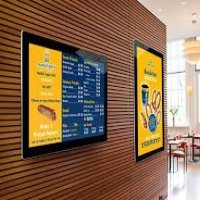
Automation is a relatively new trend in restaurants, fueled by a mostly unseen technology revolution sweeping the globe.
Read Also The 6 Best Digital Marketing Software Options for Growth in 2022
But what’s the big deal about automation in the first place?
This section will go through the broad concepts that are driving the widespread adoption of automated technologies in the restaurant business.
Workload reduction.
When it comes to repetitive activities, it’s no surprise that computers and software outperform people. Allowing computers to take over mundane but mission-critical jobs frees up employees to focus on more significant responsibilities.
Productivity has increased. When staff can focus on more significant tasks like assuring product and service quality and guiding customers rather than taking orders, the funnel expands and moves faster.
Improved customer experience.
Customers also want to make the most of their time. A more efficient and faster-moving queue can enhance the customer experience and possibly attract new consumers.
Increased revenue. Increased employee efficiency and a better guest experience promote more business, spur expansion, and boost your bottom line.
Legal compliance has improved. Certain automation systems can increase security and compliance with health and other legal requirements.
15 Uses for Automation in the Restaurant
We’ve established that automation can aid in the improvement of your restaurant’s operations.
-
Electronic menu boards
Digital menu boards are one of the most prevalent types of automation used in restaurants.
As the name suggests, digital menu boards are menus that can be viewed by a digital device. There are numerous digital menu boards available nowadays. Websites, social networking, mobile food applications, and in-store LED displays are some examples.
Furthermore, computerised menu boards are dynamic. You can adjust the display depending on your goals and customise it to reflect a holiday ambiance, support a cause, or attract attention to daily promotions. These things are not achievable with physical menus.
You can create the same appeal that your consumers love about your restaurant through your menu, whether it is displayed on several displays in your business, on mobile devices, in marketing campaigns, or on social media.
This increases brand recognition and propels your marketing plan.
-
Self-Service Kiosks
In large chain stores, self-service ordering kiosks are becoming more popular. It’s understandable why they’d use this technology, especially since the digital race has made self-ordering kiosks more available.
Using self-ordering kiosks in your restaurant has several benefits.
Reduces workload. Taking orders in a restaurant is time-consuming. Reduced load lets them focus on higher-value elements of the organization, such service quality, which can enhance customer retention.
Upselling is facilitated. Self-service machines upsell drinks, pastries, and custom parts. Self-ordering kiosks increase restaurant checks.
Sampling. Self-ordering kiosks can capture real-time data on consumer patterns and habits. These are useful for social media, email, and restaurant promotion.
Eliminates contact. Self-ordering kiosks lessen customers’ chance of getting an illness from another person.
-
Inventory Management Software
One of the most important components of a restaurant’s operation is its inventory. After all, most other functions rely on inventory: you can’t cook food without inventory, you can’t budget without inventory, and so on.
Despite this, most restaurants still manage their inventory using spreadsheets.
While this may have worked in the past, technology has advanced to the point where utilising spreadsheets to manage your inventory now is tantamount to deliberately lagging behind competition.
Nowadays, restaurant inventory software is recommended. These tools simplify the time-consuming inventory management process, keeping track of supplies, sales, orders, and deliveries.
-
Computerised Table Reservations
If you’re performing your job correctly, your restaurant’s floor area can fill up quickly. It’s easy to make mistakes while reserving tables when things get chaotic, especially if you’re utilising a manual approach.
Using table reservation software to automate table reservations allows you to maximise your front of house to be as efficient and error-free as possible. CRM subscriptions typically contain these.
To accomplish this, most table management software includes the following features:
Creates a more accurate digital floor plan by modelling your restaurant’s front-of-house.
Staffing, transfer options, reservation features, and other elements make table management easier.
No disappointment with automated table reservations can ever bring down your Yelp review because you missed their dinner reservation.
-
Telephone Buttons
Call buttons on each table reduce the social awkwardness of requesting a waiter.
Knowing that a crew is always available to assist you with your every need, within reason, is an important aspect of the restaurant customer experience. Thus, call buttons can help to speed this procedure by giving your clients a reliable way to request assistance without having to wait until a waiter notices them.
Call buttons also make it easier for waiters to serve in areas that would otherwise be inaccessible due to the layout of your restaurant. Such elements are especially beneficial in unusual or themed restaurants with a lot of coverings or interior design.
6.Accounting Software
Accounting is an important component of running a restaurant. Poor or sloppy bookkeeping, your restaurant can close your restaurant within a few weeks. Furthermore, accounting is essential for your legal requirement to document your restaurant business data.
The following approach, for restaurant owners to keep their own records, might be challenging and possibly legally problematic if not done correctly.
Accounting software, fortunately, is now widely available to many business owners. DIY accounting software interfaces into your system and keeps track of your financial data, such as expenses and profits.
-
Cooking Process Automation
The best chefs not only cook delicious cuisine, but they also create something that their clients like.
However, at its foundation, cooking is a highly regimented, repetitive process that strives for a constant outcome.
While the technology is not yet mature enough to be considered widespread, there are currently a number of brands that tailor robots in the kitchen.
Robots that are automated are very configurable, standardised, sanitary, and always efficient in their procedures. As a result, it makes sense for some companies to use automated cooking processes in their kitchens.
8.Phone Ordering by Voice
Artificial intelligence (AI) based on voice is changing the way humans interact with technology. Voice AI makes it easier than ever to obtain information and execute tasks by allowing users to control gadgets and applications with their voice. This is especially useful for businesses that take orders over the phone, such as restaurants. Customers using Voice AI can just tell the restaurant what they want to order rather than having to recall a long list of menu choices. This not only saves time but also decreases the possibility of mistakes. Furthermore, Voice AI can assist firms in upselling by making recommendations depending on the customer’s order.
-
Loyalty Programs for Digital Devices
If you want to increase the appeal of your business, one of the best things you can do is give away a lot of free products to loyal customers.
This process is automated by digital loyalty schemes. While paper coupons, cards, and discount passes have always been common, they are inefficient since they are crumpled, lost, or forgotten.
A digital loyalty program solves these issues by giving the following benefits to recurring clients.
Your clients will obtain customer loyalty points even if they fail to claim them thanks to round-the-clock tracking.
When new customers sign up, Rewards are automatically distribute
-
software for scheduling
In your day-to-day operations, staff scheduling is crucial. It’s simple to tumble into chaos without appropriate scheduling, resulting in an inefficient system that wastes company hours, lowers morale, and reduces output.
By automating set processes and making administration more accessible, scheduling software overcomes the majority of these issues.
This software helps you to create your own schedules for your employees by having all of your shift data in one place and at the correct time.
In one spot you can controll all employee hours, overtime, vacation requests, shift covers, and so on .Best of all, everything happens without the headache that an old manual, pen-and-paper, or spreadsheet approach would have caused.
11.Automated delivery System
Automated delivery drones are currently being used in well-known businesses like as logistics and delivery services.
Because food ordering and delivery follow a similar pattern and automated deliveries are poised to transform the meal delivery sector. Furthermore, with Covid-19 uncertainty still there, customers are more likely to continue using online ordering and delivery services for years to ahead.
If you are primarily a QSR (quick-service restaurant) with a strong delivery element, automating deliveries can make your services more accessible to your clients.
12.Mobile Point-of-Sale
A mobile POS system allows clients to finish their purchases without having to enter a specific area of the restaurant.
Some restaurants use dedicated tablets with point-of-sale software per table to allow guests to select and pay for their food without leaving their seat.
In the ordering system you can include Other services like entertainment, games and integrations.
Mobile POS simplifies the sales process even further, encouraging additional spending and increasing average check sizes.
13 Video Auditing Software
Your security system is a critical component for the continuous success of your business. Even if you have a good CCTV system, your restaurant is still exposed to security breaches and staff fraud.
By employing AI to recognize and catalogue images from your cameras, video auditing subscriptions allow you to avoid all of the inherent drawbacks of old CCTV systems.
Video auditing technologies, in essence, give your CCTVs a brain. This enables you to integrate useful features such as detecting theft in real time, monitoring inventories, and more.
-
Table Self-Service Ordering
Each table has a self-service ordering kiosk that blends self-service kiosks and mobile POS features. Customers can order at their table without getting up, however they cannot use the system to make payments.
Nonetheless, it simplifies the ordering procedure because waiters are no longer need to wait for customers to get their orders.
This translates into faster table turnover due to less waiting time, resulting in more revenues.
-
Voice Recognition for Drive-In and Drive-Thru
Customers may quickly place orders using natural language with companies like SoundHound, eliminating the need to memorise specific menu items or prices. This not only saves time, but also helps to decrease misunderstanding and streamline the ordering process.
By proposing extra things based on the customer’s order, voice AI can also assist restaurants in upselling and cross-selling. If a consumer wants a burger, the Voice AI system may advise that they add fries or a soft drink to their order. Restaurants may improve the customer experience and increase sales by using Voice AI into their operations.
Measuring Restaurant Sales Success
Using automation technologies helps you to perform one important thing: collect data. Restaurants can collect consumer data from digital menu boards to table self-service screens and use it to improve the customer experience.
But what do you do with the data once you have it? The answer is straightforward: you examine KPIs and track your progress in restaurant sales.
What exactly is a KPI?
KPI stands for key performance indicators, and as you might expect, they are measurements that tell you specific things about the success of your restaurant.
KPIs are important since they serve as a yardstick against which you can assess your development. You will be lost in a sea of data if you do not use KPIs.
Restaurant Key Performance Indicators KPIs to Monitor
Your restaurant approach must be highly personalised for your establishment. You must sit down with your employees and some analysts to develop precise KPIs that are unique to your restaurant.
There are, however, common restaurant KPIs that everyone believes provide varied levels of information into your business. These are ..
The overhead margin
Profit margin (gross profit)
Profit margin net
Sales in the past
The average check per server The number of guests served each hour
Time spent per table turn
Customer fulfilment
Your restaurant may easily track these KPIs using automated solutions without hurting your back with specialist tools.
Using Automation to Increase Restaurant Sales
The restaurant sector is inherently competitive. And, in this day and age, the battleground has grown to encompass restaurant technology, most likely because technology is now inextricably related to a good customer experience.
Using automation technologies will catapult your restaurant service to the forefront of your specialty by making your procedures more effective, lowering expenses, and generating high-quality consumer data.






